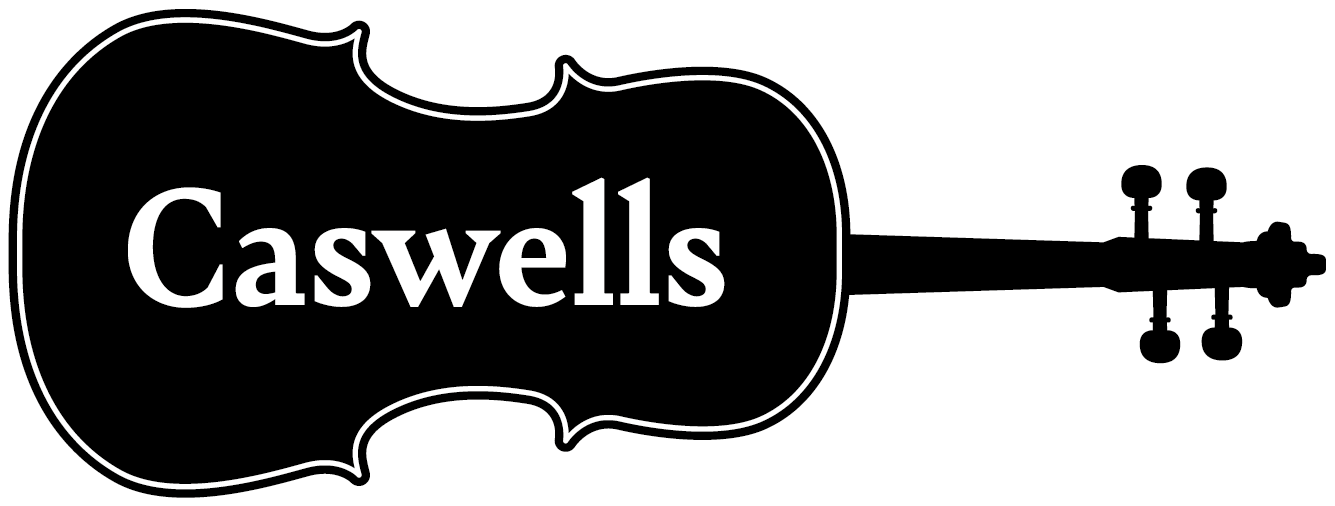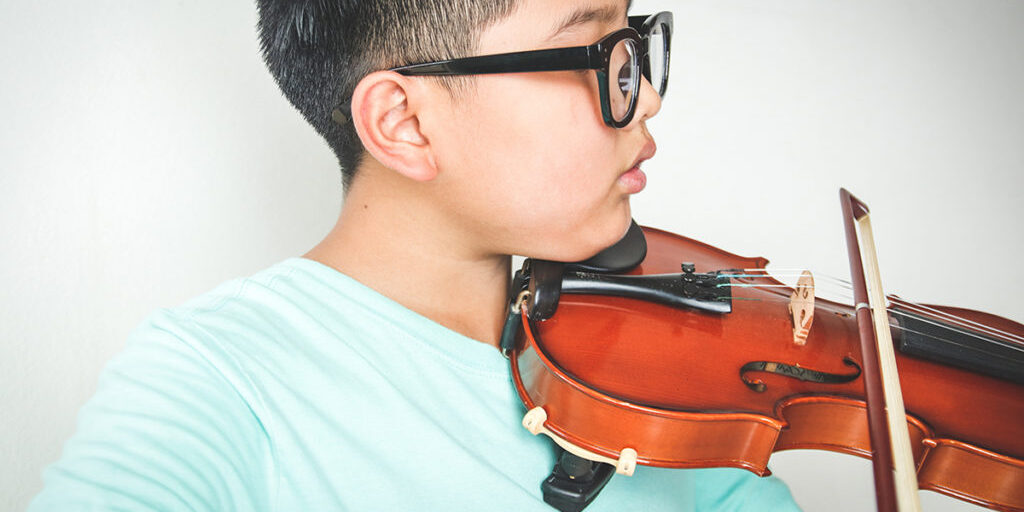How To Choose A Violin Shoulder Rest

Learning to play the violin is a lengthy process and many of the techniques will initially feel strange to your child or student. Between the pressure against their jaw and the way the violin sits on their shoulder, the different points of contact may feel uncomfortable, especially because of the direct contact between the violin body and the violinist.
Although there is considerable debate around the use of violin shoulder rests (in the name of tradition), many teachers and professional players believe that they are an essential violin accessory to be used, especially for children.
In this guide, we will outline the benefits of using a shoulder rest and how you can choose the right one for you or your little violinist.
What is a violin shoulder rest?
A violin shoulder rest is an accessory that fixes to the back of a violin. This can be done by securing the rest to the edges of the back of a violin with ‘feet’ padded with rubber; by sticky feet or with elastic bands. Shoulder rests are designed to create a more comfortable position and decrease the direct contact against the shoulder when the violin is held in a playing position.
Basic designs improve the stability of the violin position and prevent slipping as the rest follows the curve of the shoulder. Some styles improve this by being bendable or compressible and a few have extensions that hook further across the shoulder for added solidity.
Violin shoulder rests, although not used by every violinist, can be used by any player; from beginner to advanced and of any age as shoulder rests are available in different sizes.

How to choose a violin shoulder rest
Violin shoulder rests are very personal to the individual violinist. Choosing an appropriate shoulder rest can assist with conditioning position and should be used as early into the learning process as possible for proper form.
A well-shaped violin shoulder rest will help with better left-hand positioning and, as mentioned previously, can keep the violin secure in its position.
So what are the key things that need to be considered when choosing a violin shoulder rest?
Size
One size does not fit all, just as one size of the violin is not suitable for all ages and students. A violin shoulder rest should contour smoothly to the shoulder of the violinist. Depending on your child’s body shape, a shoulder rest that cups the upper part of their back, and supports the violin well on the front, will be the best fit.
There are also other aspects to consider such as your child’s shoulder breadth and neck height. However, many violin shoulder rests are adjustable and can be lowered or raised to get the correct position.
When it comes to numerical sizing, shoulder rests are given the same size as the instrument, such as a violin 4/4 shoulder rest would be for a 4/4 or full-size violin.
Material
Materials (as with all parts of a violin) can be an important factor, but not really a game-changer if you’re a beginner. The main materials used in their design includes wood, rubber, foam, metal, and plastic.
Wood or plastic are primarily used as the base materials. Strengths include durability, lightweight, and not too restrictive, with a finish that is smooth and stylish. However, as the hard base cannot be bent to fit the shape of your shoulder (except for very expensive models) they are always padded out with foam to improve fit and comfort.
While foam is mainly used for padding the base to improve comfort, in the junior grades teachers often prefer a sponge or soft rubber foam held on with rubber bands
Some shoulder rests are made almost entirely of hardened rubber, though you’ll mostly find rubber on the feet rests so that the violin body isn’t marked. Rubber rests are also flexible and affordable.
Metal is, in some way, featured on many shoulder rest because of the versatility of the material and its ability to strengthen other materials. If the body isn’t made from metal there’s usually a chance that the posts in the legs are. Some models feature metal bases. When used as a base, soft and bendable types of metal allow players to shape the rest to their liking.
Choosing a material is most importantly about comfort. Many beginners may find wooden or metal shoulder rests heavy and uncomfortable. That’s why, for beginners, we typically suggest a foam-based plastic such as KUN or VIVA as this offers the most comfortable fit against the shoulder.
Clamp
Made from a long piece of material with adjustable ‘feet’, this type of rest fits on either side of the violin and is raised away from the violin body. This gives more options for height based on the personal neck length and build of the violinist.
This design of violin shoulder rest also comes in a variety of styles, with some simply propping against the arch of the shoulder and others coming down around the shoulder blade and chest to provide a sturdy hands-free option.
Shoulder pads
These all sponge, all-foam shoulder pads are a block of squishy material, indented in the centre to fit around the violinist’s shoulder. Although less common than the clamp alternative, they are easier to put on and will be the softest feel on the body.
The AcoustaGrip violin shoulder rest range offers a unique solution to a problem that nearly every violinist is faced with. With the AcoustaGrip you can have the secure grip of a traditional shoulder rest without the discomfort and restriction of movement.
The Protégé series are for smaller violins. For young players, letting them apply their own shoulder rest is easy because they just ‘stick’ to the violin without glue or clamps with no damage to the instrument.

How to put a shoulder rest on a violin
Once you’ve chosen the appropriate violin shoulder rest, it’s important to teach your child or student (and yourself if you are a supportive parent) how to fit a shoulder rest with respect for the instrument and to get the best fit. There is such variation of shoulder rests that we cannot set out too many techniques here, but rather get your teacher to set it up once or twice and you will soon get the technique.
As a popular shoulder rest option that can sometimes cause confusion, here are some brief tips on fitting the ‘footed’ type:
- For the shoulder rests with feet, it is easiest to simply grasp the violin face-up in your left hand with the tailpiece facing back.
- Next with your right hand just slip the foot onto the edge and clamp it there with your index finger
- Then slide the right-hand foot over the top of the instrument and gently slide them both down to an angle that is both firm and comfortable
Need more assistance? Our Youtube Channel features a series on violin shoulder rests with guides on how to fit individual brands and models! You can see some for yourself below.
What is the best violin shoulder rest?
You can browse through many designs on our website, but ultimately your teacher’s input is invaluable.
Some of the most popular ‘footed’ types are :
KUN violin shoulder rests in 4 models
The practical, uncomplicated design of the Kun Original shoulder rest, with its simple adjusting mechanisms, has made it the favourite of amateur and professional players alike. The Kun Original is fully adjustable for height and features a contoured shape for a close, personal fit. It is available for full 4/4 or 1/2 & 3/4 size violin. For 1/16 to 1/4 size see KUN Mini and KUN Collapsible.
Canadian made, this shoulder rest is made from a strong thermoplastic frame, a soft sponge rubber pad and rubber encased, metal feet for a secure fit and sympathetic feel.
Bonmusica violin shoulder rest
The Bonmusica violin shoulder rest is completely adjustable making it very versatile. Adjusted to exactly how you want it, the Bonmusica Violin shoulder rest is solid, stable and comfortable.
The padded base ‘hooks’ over the player’s shoulder, holding the instrument in place instead of it sliding off the shoulder, allowing for good technique and easy shifting and vibrato. This base can be contoured to the player’s shoulder precisely and make it as comfortable as possible. The bottom of the base is also free from the legs and can also be adjusted.
The Bonmusica shoulder rests are German designed and German-made, quality shoulder rests which are proving increasingly popular.
Everest violin shoulder rests
The Everest Violin Shoulder rest is an ABS shoulder rest, virtually unbreakable, and increasingly popular due to the comfort and the striking colour choices.
It has an ergonomically designed fixed tilt with adjustable width and height. It’s also made from an improved neoprene foam material and adhesive thereby enhancing the durability. The Patent pending ‘grippers’ which are ‘no skid’ and wear-resistant are very effective.
The Everest shoulder rest has quickly become a very popular shoulder rest, despite being a fairly new player in a crowded field.
The shoulder rest is available in a variety of unique and attractive colours so that your child can have some fun selecting a colour that means something to them with their instrument. The rest comes in 4/4, 3/4, 1/2 and 1/4 size.
Wolf violin shoulder rest
The Wolf Violin shoulder rest has both height and pitch adjustment. The padded rest is comfortable to use and fits both 4/4 and 3/4 violins.
The main part of the shoulder rest is made of comfortable rubber on top of an aluminium plating, making it possible for the player to shape the rest to their own shape for maximum comfort. Included with the Wolf Violin shoulder rest are two plastic spacing tubes which allow the arms to be stable when put into the highest position.
The Primo is also available in a Wolf Forte Primo Superflexible model for added versatility and fit.
Where to buy violin shoulder rests
As long-standing favourites, our range of violin shoulder rests are the best choice for beginners with fantastic brands such as Kun, Wolf, Bonmusica or Everest being perfect additions for those with a little more experience.
When it comes to buying a violin, you want to ensure that your child has everything they need from the very beginning of their violin journey. That’s why we stock thousands of products online and a huge range in-store so that you can get all of your violin necessities in one convenient place.
Our prompt delivery service means that we can have instruments and accessories to you in no time at all.
If you’re undecided and in the area, you’re most welcome to spend some time in the shop trying them to find one that suits you. Otherwise, just contact our knowledgeable team on 01280 707 140 or email sales@caswellstrings.com
Recommended articles for you…
Violin Pickups—When to Use Them
5 Ways to Support your Child when Learning the Violin
This article was checked by the director of Caswell’s Strings, Lance Tunley who is an experienced purveyor of stringed instruments and accessories with over 30 years of experience in the field.





